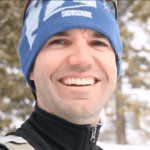This article originally appeared on the Winter Wildlands Alliance website, and was republished with permission.

It’s January in the quiet mountain town of Greenville, California. This is the heart of the Lost Sierra; an impressive expanse of rolling mountains and vast forest that are as remote as they are beautiful. At Indian Valley Elementary in the Plumas County School District, it is day one of a series SnowSchool experiences planned for the 6th graders. And just like SnowSchool outings at the other 65+ program locations across the country, this day will be filled with hands-on science in the snow-filled wilds of winter. A unique quality of this particular SnowSchool site however, is a specific focus on connecting students with local public lands and utilizing the snow right outside the school.

The day begins with a quick but critical classroom introduction to essential science concepts. Students jot down notes in their field journals about concepts like watershed, water supply, snowpack depth, snow density, and the water cycle—all important foundations of the snow hydrology-focused SnowSchool curriculum. As part of the introduction, educators including Rob Wade (Plumas County’s outdoor education coordinator), hand each student a snowpack density cutter. This is the same tool used by NASA snow scientists to precisely measure snowpack water content (more on the NASA–SnowSchool connection in a bit). The idea is that the student will extract samples of snow from the snowpack, weigh each sample, and calculate the water content. After some wrestling with the math formulas, the students are ready to head out into the schoolyard.
This the part that represents the most exciting innovation of this newest version of the SnowSchool program model: charging out the back door of the school to explore winter and the science of snow, not just once, but throughout the season and at every grade level Kindergarten through 12th Grade. As these 6th graders excitedly romp across the snow-covered school yard to dig their snowpits and extract snow samples, they know this is just one of a multitude of SnowSchool experiences coming their way over the coming years. Designed with input from educators and scientists, these activities grow in complexity and sophistication through the grade levels. After the 6th graders weigh their samples and calculate density and snow water equivalent of the schoolyard, they board a waiting school bus. A quick 15-minute drive takes them higher into the Plumas National Forest in search of deeper mountain snow. Here the students will spend the rest of their day immersed in the wilds of winter observing wildlife, looking at snow crystals under microscopes, digging snow pits, and making valley-to-mountain snowpack comparisons.

Bringing SnowSchool’s unique outdoor snow science to rural school districts like Plumas County has become a top priority for Winter Wildlands Alliance (WWA) in recent years. Though it may seem counterintuitive, data suggests that even students in rural areas with ample public lands are spending less and less time outside. SnowSchool serves as an important means to help rural students learn about, appreciate, and understand the value of our public lands.

From the beginning, a key goal of this project has been to make this model replicable in other rural school districts. Several hundred miles away in the mountains of central Idaho, a similar project is underway. Here, the Basin School District is surrounded by the towering Ponderosa Pine and Douglas Fir trees of the Boise National Forest. Working collaboratively with WWA, the district has designed and planned snowshoe-powered SnowSchool outings for every one of the 400+ students in the district. The science curriculum that accompanies these outings utilizes the surrounding snowpack and adjacent United States Forest Service lands.
An exciting opportunity for these Basin School District students is the upcoming 2019 NASA SnowEx campaign. The district sits directly in NASA’s proposed flight path; this means because of an ongoing NASA scientist–SnowSchool collaboration, these students will be collecting snowpack data in the near future that will contribute to cutting-edge NASA snow science research. During SnowEx, scientists will be testing out new Light Detection and Ranging, microwave, and infrared technology designed to scan the mountain snowpack from aircraft. The hope is to one day develop the technological capacity to detect in real-time, from an aircraft or satellite, the water content of snow in a mountain watershed. This is something increasingly valuable and critical in a changing and unpredictable climate, especially in the Western US where mountain snow contributes up to 80% of the annual water supply. SnowSchool students on the ground will get to contribute to the research and fine-tuning of this technology by collecting accurate snow depth and density measurements (via the Snowmetrics tools described above) for comparison.

These exciting developments wouldn’t be possible without support from our friends at The North Face Explore Fund, KEEN, REI, Osprey Packs, Mountain Safety Research, CLIF Bar, and Snowmetrics. Introducing thousands of kids to the joy of being outside in winter takes a community, and we appreciate everyone who has pitched in to help make it happen!
Want to know more about the Plumas County CA program? Check out their website and vision for their Learning Landscapes program that was developed in conjunction with the school district and the Feather River Land Trust. Great stuff!
Interested in bringing SnowSchool to your community? We add new SnowSchool sites to the national network every winter! Email Kerry McClay at kmcclay@winterwildlands.org for more information.

